Numerical Simulation of Urban Natural Gas Leakage Dispersion: Evaluating the Impact of Wind Conditions and Urban Configurations
Abstract
1. Introduction
2. Materials and Methods
2.1. Governing Equations
2.2. Domains
2.3. Numerical Setups
3. Results
3.1. Canyon Structure Effect
3.1.1. Wind Field Distributions under South Wind at Beaufort Level 2
3.1.2. Pollutant Concentration Distribution under Beaufort Level 2 South Wind
3.1.3. Wind Field Distribution under Beaufort Level 2 East Wind
3.1.4. Pollutant Concentration Distribution under Beaufort Level 2 East Wind
3.2. Wind Speed Effect
3.3. Near-Ground Pollutant Distribution under Different Conditions
3.3.1. Near-Ground Pollutant Distribution under South Wind at Different Speeds
3.3.2. Near-Ground Pollutant Distribution under East Wind at Different Speeds
4. Conclusions
- This study identified unique pollutant distribution patterns associated with specific combinations of building structures and wind directions. Notably, when the wind is perpendicular to or parallel to buildings, pollutant dispersion exhibits distinctive characteristics that could potentially be used to predict the location of gas leaks. This insight paves the way for developing predictive models that utilize pollutant distribution data, along with wind conditions, to accurately locate leak sources.
- Our analysis shows that urban canyons, formed by buildings, have a profound effect on natural gas dispersion. Specifically, under a Beaufort level 2 south wind, gas tends to accumulate in low-speed zones behind buildings.
- Wind speed and direction are pivotal in determining the concentration and distribution of pollutants at ground level. Our findings reveal that higher wind speeds significantly improve natural gas dispersion, thereby minimizing the formation of high-concentration zones close to leak sources. This emphasizes the need for emergency plans and gas detection strategies to incorporate local meteorological data for enhanced effectiveness.
Author Contributions
Funding
Institutional Review Board Statement
Informed Consent Statement
Data Availability Statement
Acknowledgments
Conflicts of Interest
References
- Explosion Equivalent to Approximately 80 kg of TNT, Cause of Shenyang Explosion Resulting in 5 Deaths Announced. Beijing Youth Daily, 16 January 2022. Available online: www.mem.gov.cn/xw/ztzl/2021/qgczrqaqpczz/pgt_4342/202201/t20220116_406772.shtml (accessed on 8 February 2024).
- 13 Typical Accidents! Another Reminder for Gas Safety! Pengpai News, 4 July 2023. Available online: www.thepaper.cn/newsDetail_forward_23726572 (accessed on 8 February 2024).
- Ministry of Emergency Management of the People’s Republic of China. Urging to Profoundly Learn from Accident Lessons, Promoting the Strengthening and Implementation of Safety Responsibilities. 2 October 2021. Available online: www.mem.gov.cn/xw/yjglbgzdt/202110/t20211002_399521.shtml (accessed on 8 February 2024).
- California Air Resources Board, Aliso Canyon Natural Gas Leak. 8 August 2018. Available online: https://ww2.arb.ca.gov/our-work/programs/aliso-canyon-natural-gas-leak (accessed on 26 March 2024).
- The Brussels Times, Tribute to the Victims of the Ghislenghien Explosion, 12 Years on. 31 July 2016. Available online: https://www.brusselstimes.com/38501/tribute-to-the-victims-of-the-ghislenghien-explosion-12-years-on (accessed on 26 March 2023).
- Knobelspies, S.; Bierer, B.; Perez, A.O.; Wöllenstein, J.; Kneer, J.; Palzer, S. Low-cost gas sensing system for the reliable and precise measurement of methane, carbon dioxide and hydrogen sulfide in natural gas and biomethane. Sens. Actuators B Chem. 2016, 236, 885–892. [Google Scholar] [CrossRef]
- Barriault, M.; Alexander, I.; Tasnim, N.; O’Brien, A.; Najjaran, H.; Hoorfar, M. Classification and regression of binary hydrocarbon mixtures using single metal oxide semiconductor sensor with application to natural gas detection. Sens. Actuators B Chem. 2021, 326, 129012. [Google Scholar] [CrossRef]
- Aldhafeeri, T.; Tran, M.-K.; Vrolyk, R.; Pope, M.; Fowler, M. A review of methane gas detection sensors: Recent developments and future perspectives. Inventions 2020, 5, 28. [Google Scholar] [CrossRef]
- ABB. ABB Ability™ Mobile Gas Leak Detection System. 7 April 2021. Available online: https://new.abb.com/products/measurement-products/analytical/laser-gas-analyzers/advanced-leak-detection/abb-ability-mobile-gas-leak-detection-system (accessed on 8 February 2024).
- Yan, G.; Zhang, L.; Zheng, C.; Zhang, M.; Zheng, K.; Song, F.; Ye, W.; Zhang, Y.; Wang, Y.; Tittel, F.K. Mobile Vehicle Measurement of Urban Atmospheric CH4/C2H6 Using a Midinfrared Dual-Gas Sensor System Based on Interband Cascade Laser Absorption Spectroscopy. IEEE Trans. Instrum. Meas. 2022, 71, 9509411. [Google Scholar] [CrossRef]
- Liu, A.; Huang, J.; Li, Z.; Chen, J.; Huang, X.; Chen, K.; Xu, W.b. Numerical simulation and experiment on the law of urban natural gas leakage and diffusion for different building layouts. J. Nat. Gas Sci. Eng. 2018, 54, 1–10. [Google Scholar] [CrossRef]
- Peng, S.; Li, C.; Liu, E.; Liao, K.; Wang, W.; Li, J. Numerical simulation of natural gas pipeline leakage. In Proceedings of the ICPTT 2011: Sustainable Solutions For Water, Sewer, Gas, and Oil Pipelines, Beijing, China, 26–29 October 2011; pp. 1502–1511. [Google Scholar]
- Yang, J.; Zhang, J.; Mei, S.; Liu, D.; Zhao, F. Numerical simulation of sudden gas pipeline leakage in urban block. Energy Procedia 2017, 105, 4921–4926. [Google Scholar] [CrossRef]
- Dezfouli, A.M.; Saffarian, M.R.; Behbahani-Nejad, M.; Changizian, M. Experimental and numerical investigation on development of a method for measuring the rate of natural gas leakage. J. Nat. Gas Sci. Eng. 2022, 104, 104643. [Google Scholar] [CrossRef]
- Yuan, F.; Zeng, Y.; Khoo, B.C. A new real-gas model to characterize and predict gas leakage for high-pressure gas pipeline. J. Loss Prev. Process Ind. 2022, 74, 104650. [Google Scholar] [CrossRef]
- Tong, S.; Li, X.; Ding, H.; Shuai, J.; Mei, Y.; Chan, S.H. Large-scale transient simulation for consequence analysis of hydrogen-doped natural gas leakage and explosion accidents. Int. J. Hydrogen Energy 2024, 54, 864–877. [Google Scholar] [CrossRef]
- Cai, P.; Li, M.; Liu, Z.; Li, P.; Zhao, Y.; Zhou, Y. Experimental and numerical study of natural gas leakage and explosion characteristics. ACS Omega 2022, 7, 25278–25290. [Google Scholar] [CrossRef]
- Zhou, K.; Li, F.; Cai, H.; Jing, Y.; Zhuang, J.; Li, M.; Xing, Z. Estimation of the natural gas leakage source with different monitoring sensor networks in an underground utility Tunnel: From the perspectives of energy security. Energy Build. 2022, 254, 111645. [Google Scholar] [CrossRef]
- Bagheri, M.; Sari, A. Study of natural gas emission from a hole on underground pipelines using optimal design-based CFD simulations: Developing comprehensive soil classified leakage models. J. Nat. Gas Sci. Eng. 2022, 102, 104583. [Google Scholar] [CrossRef]
- Blocken, B.; Carmeliet, J. Pedestrian wind environment around buildings: Literature review and practical examples. J. Therm. Envel. Build. Sci. 2004, 28, 107–159. [Google Scholar] [CrossRef]
- Tominaga, Y.; Stathopoulos, T. CFD simulation of near-field pollutant dispersion in the urban environment: A review of current modeling techniques. Atmos. Environ. 2013, 79, 716–730. [Google Scholar] [CrossRef]
- Franke, J.; Hellsten, A.; Schlünzen, H.; Carissimo, B. Best practice guideline for the CFD simulation of flows in the urban environment. In COST Action 732: Quality Assurance and Improvement of Microscale Meteorological Models; COST Office: Brussels, Belgium, 2007. [Google Scholar]
- Xie, Z.-T.; Castro, I.P. LES and RANS for turbulent flow over arrays of wall-mounted obstacles. Flow Turbul. Combust. 2009, 82, 225–247. [Google Scholar] [CrossRef]
- Salim, S.M.; Buccolieri, R.; Chan, A.; Di Sabatino, S. Numerical simulation of atmospheric pollutant dispersion in an urban street canyon: Comparison between RANS and LES. J. Wind. Eng. Ind. Aerodyn. 2011, 99, 103–113. [Google Scholar] [CrossRef]
- Kahl, J.D.; Chapman, H.L. Atmospheric stability characterization using the Pasquill method: A critical evaluation. Atmos. Environ. 2018, 187, 196–209. [Google Scholar] [CrossRef]
- Gryning, S.E.; Batchvarova, E.; Brümmer, B.; Jørgensen, H.; Larsen, S. On the extension of the wind profile over homogeneous terrain beyond the surface boundary layer. Bound. Layer Meteorol. 2007, 124, 251–268. [Google Scholar] [CrossRef]
- Duynkerke, P.G. Application of the E–ε turbulence closure model to the neutral and stable atmospheric boundary layer. J. Atmos. Sci. 1988, 45, 865–880. [Google Scholar] [CrossRef]
- Jones, W.P.; Launder, B.E. The prediction of laminarization with a two-equation model of turbulence. Int. J. Heat Mass Transf. 1972, 15, 301–314. [Google Scholar] [CrossRef]
- Ma, X.; Zhong, W.; Feng, W.; Li, G. Modelling of pollutant dispersion with atmospheric instabilities in an industrial park. Powder Technol. 2017, 314, 577–588. [Google Scholar] [CrossRef]
- Hargreaves, D.M.; Wright, N.G. On the use of the k–ε model in commercial CFD software to model the neutral atmospheric boundary layer. J. Wind Eng. Ind. Aerodyn. 2007, 95, 355–369. [Google Scholar] [CrossRef]
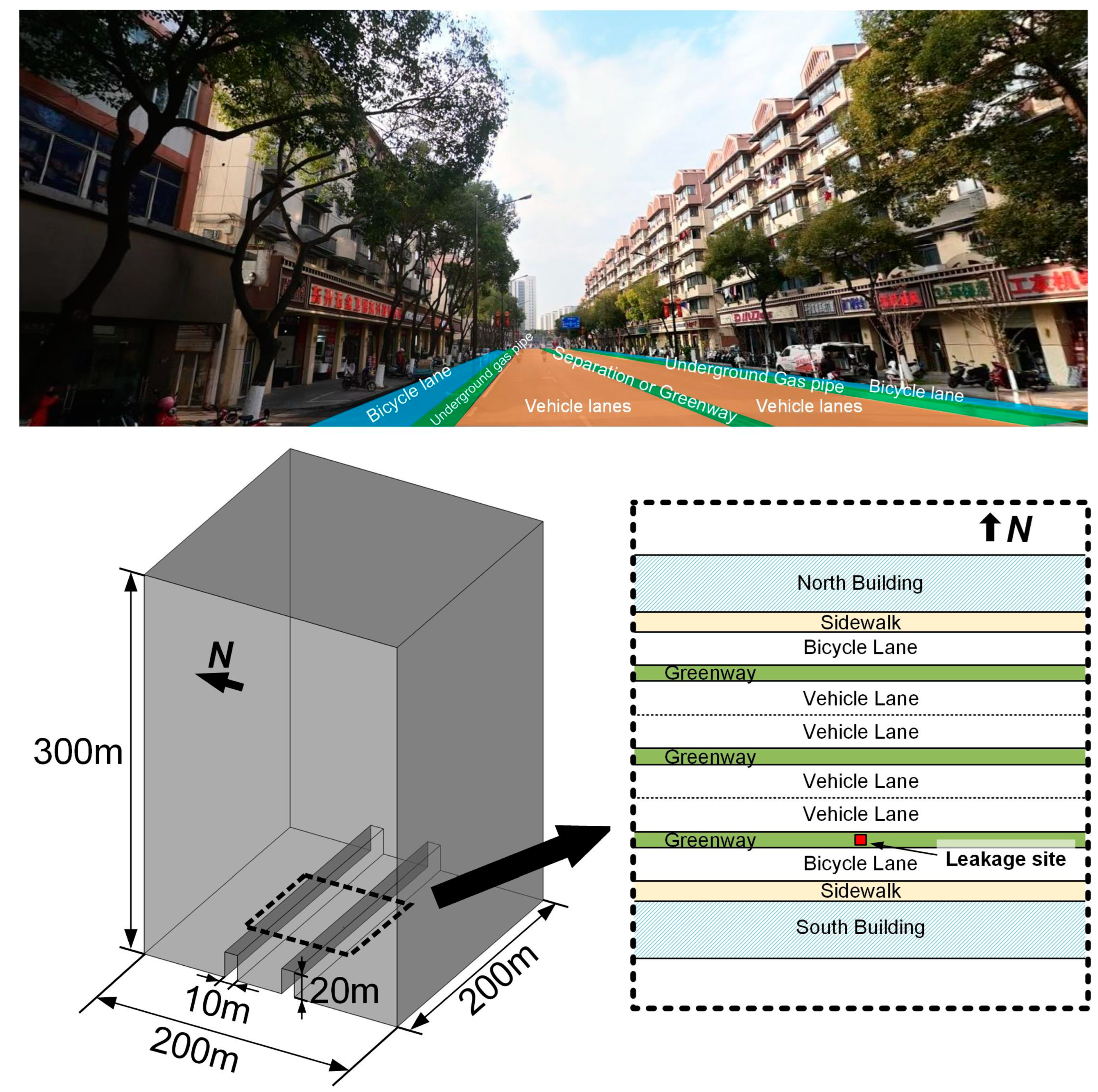

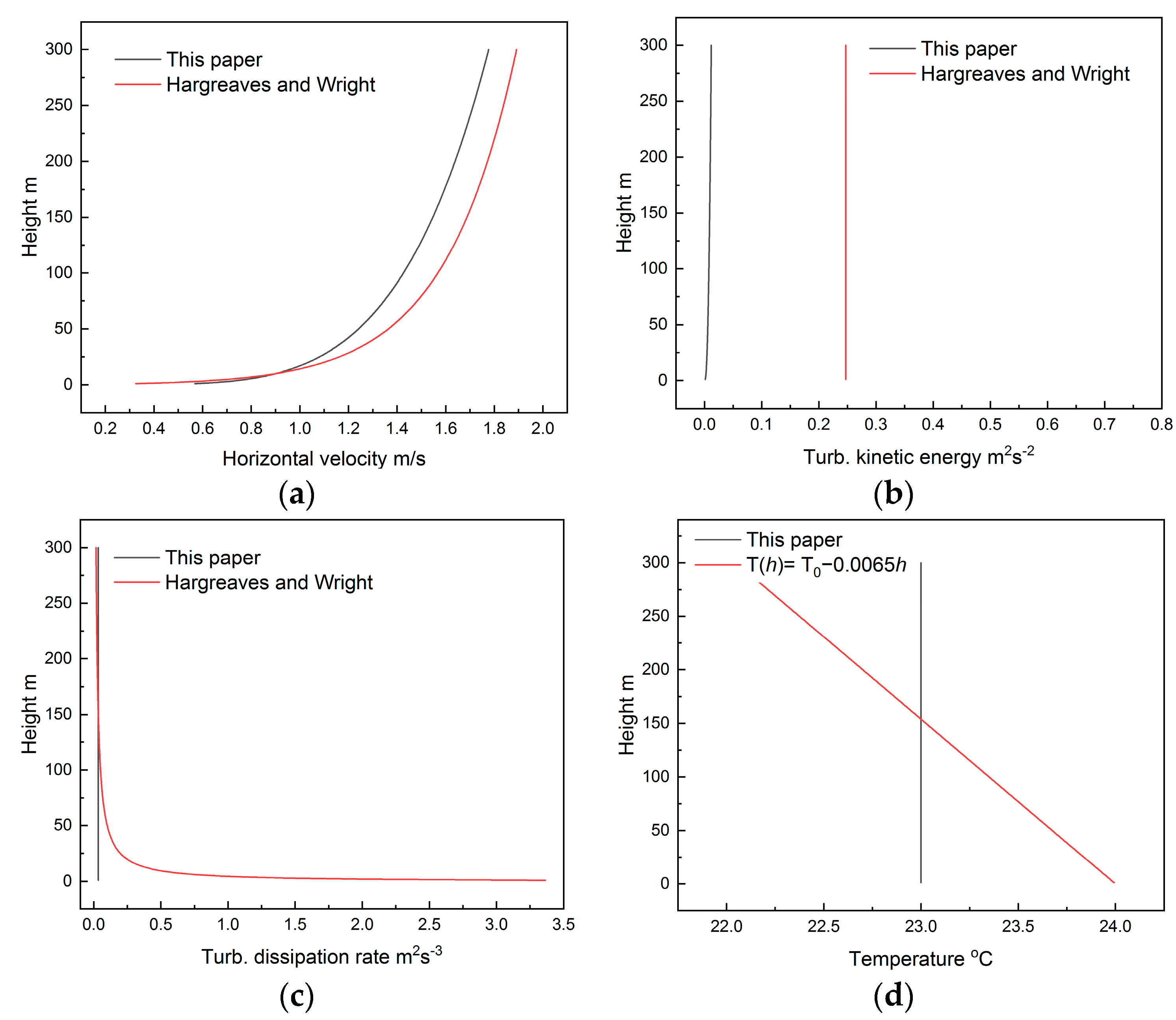
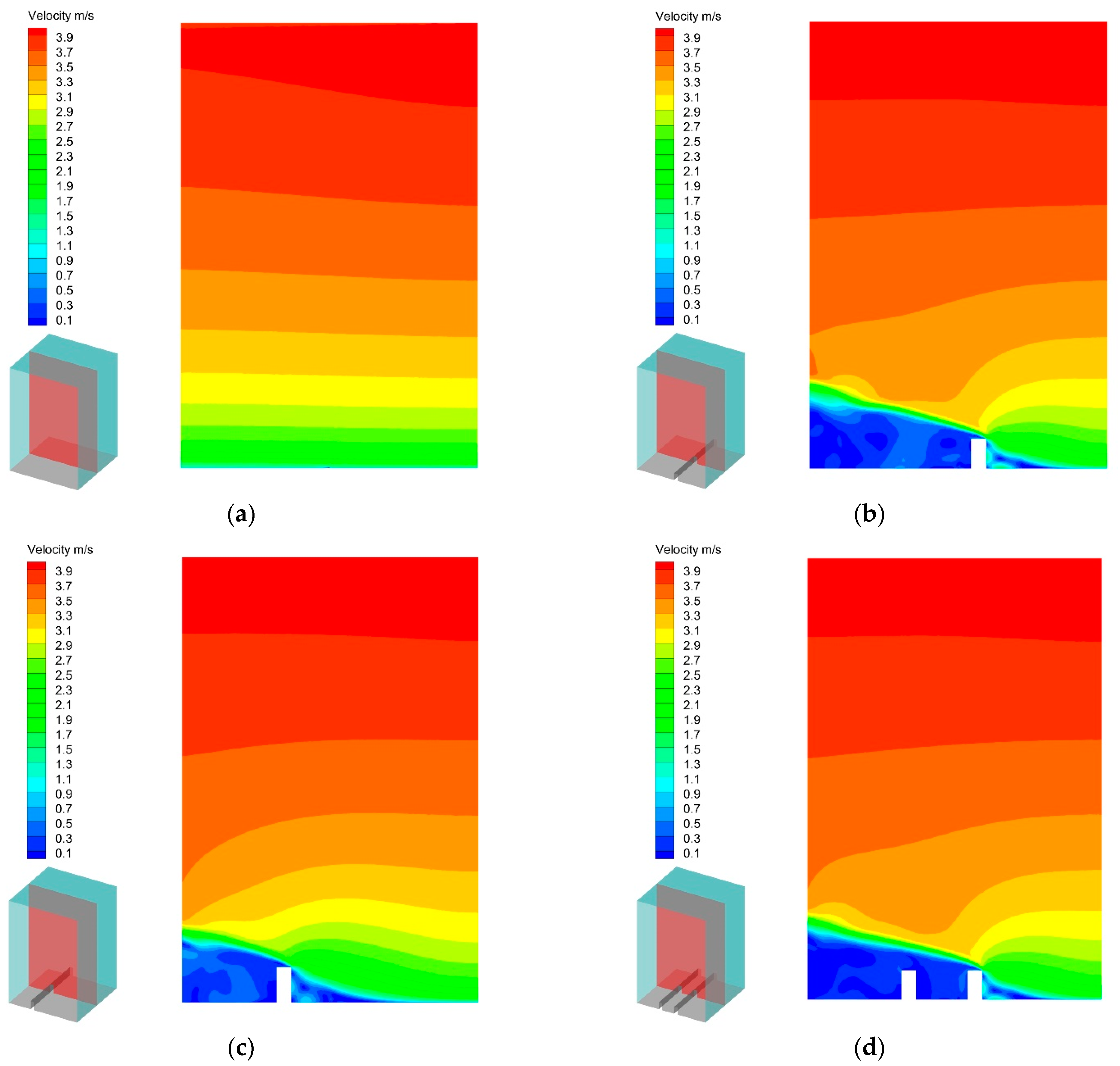

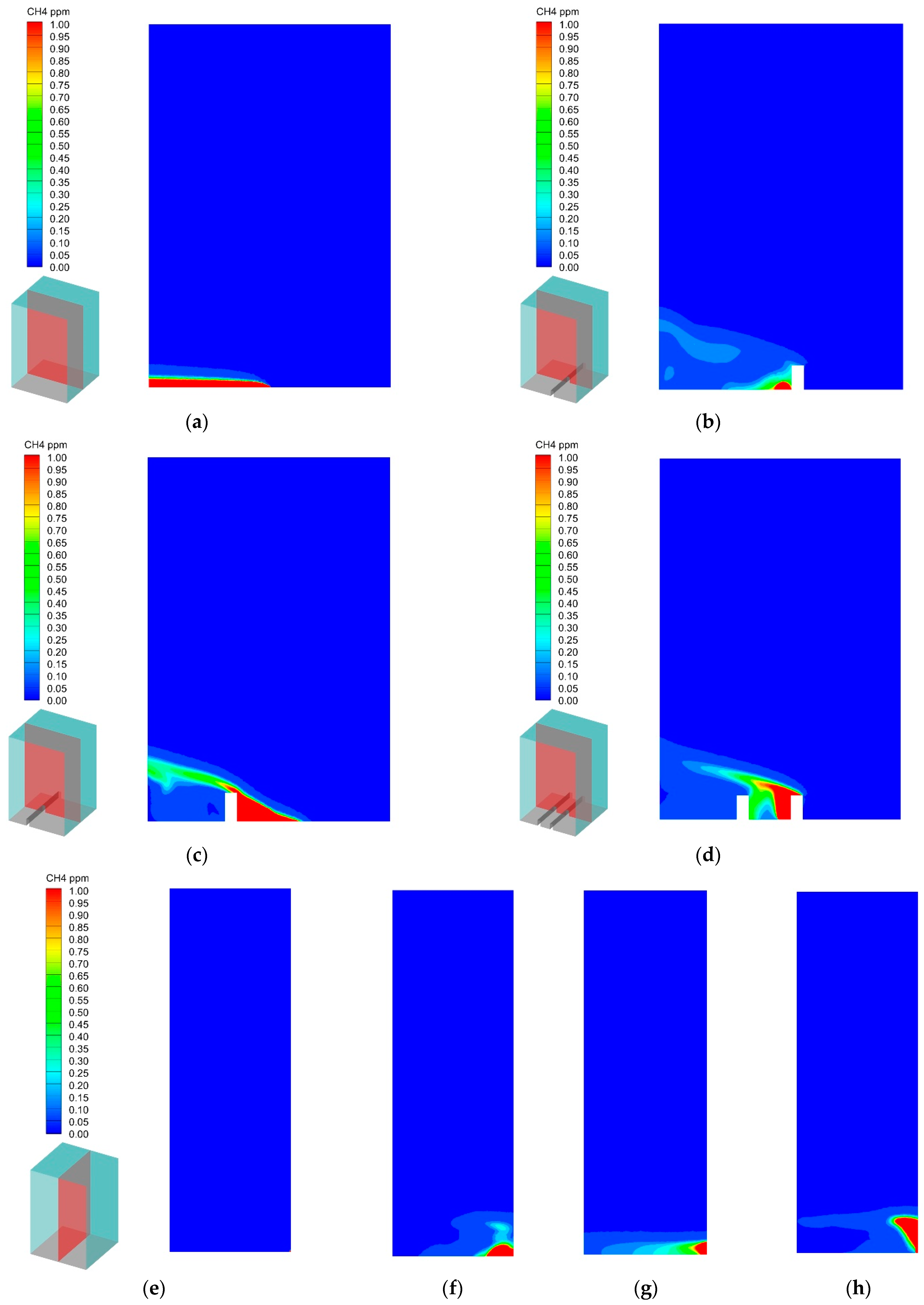

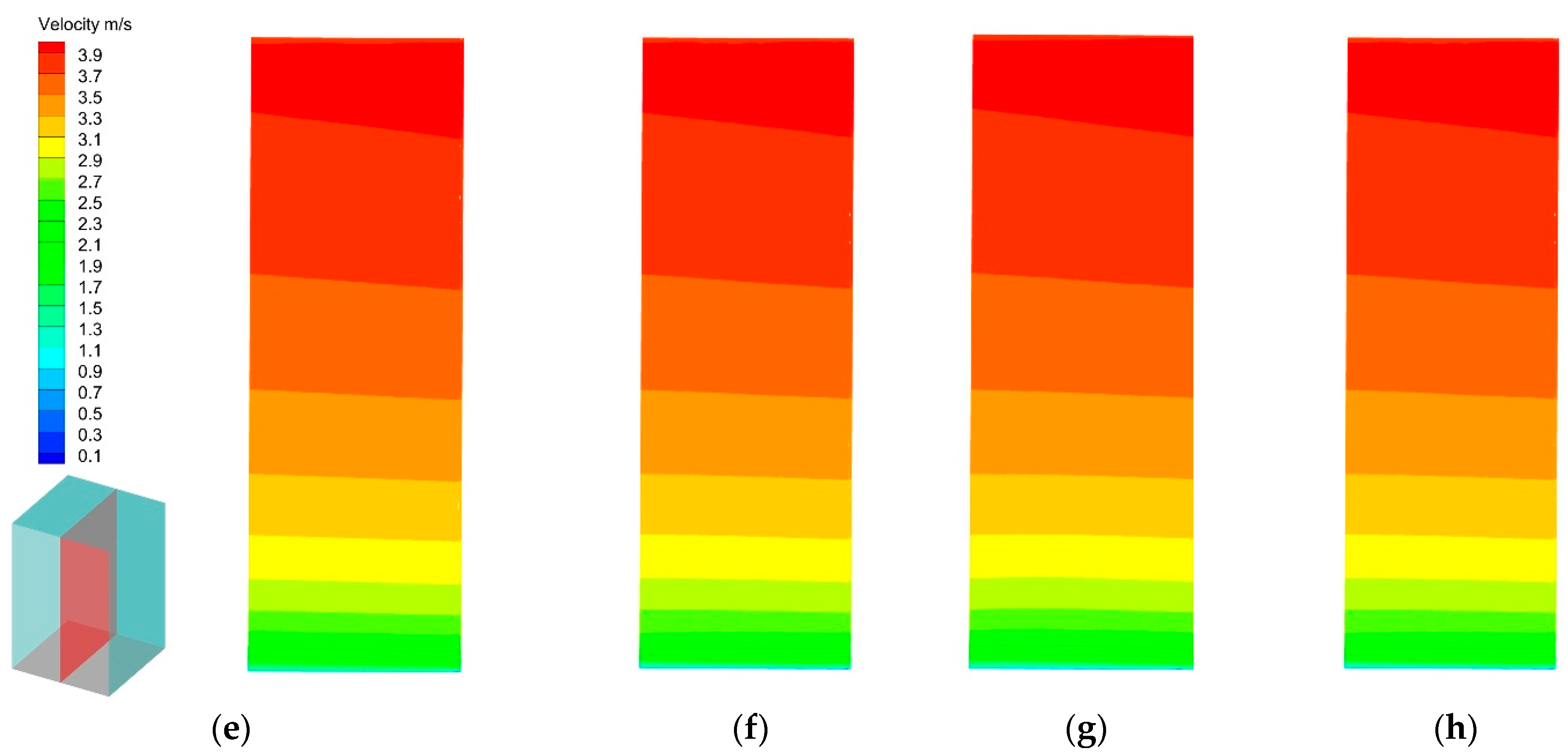


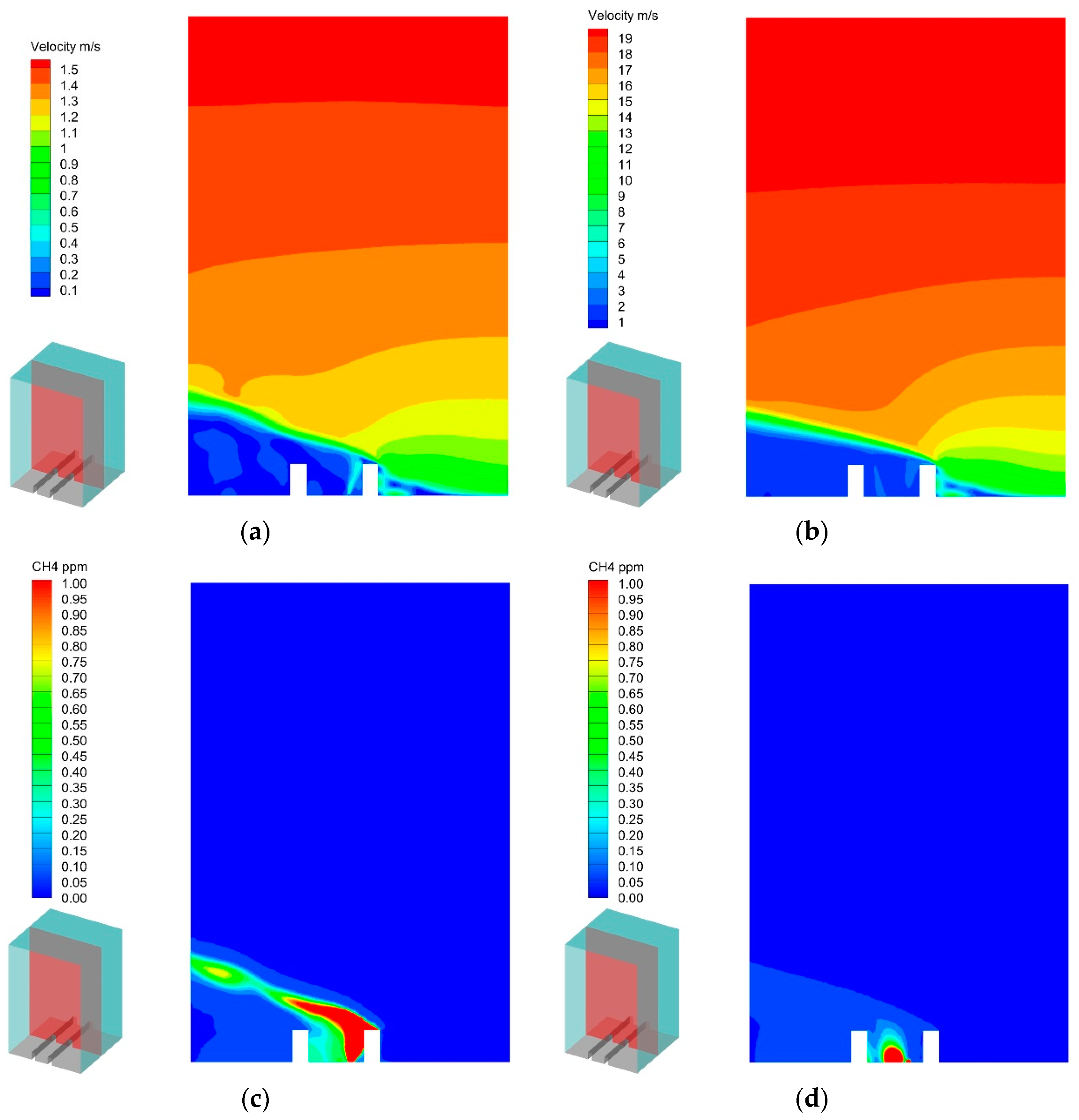
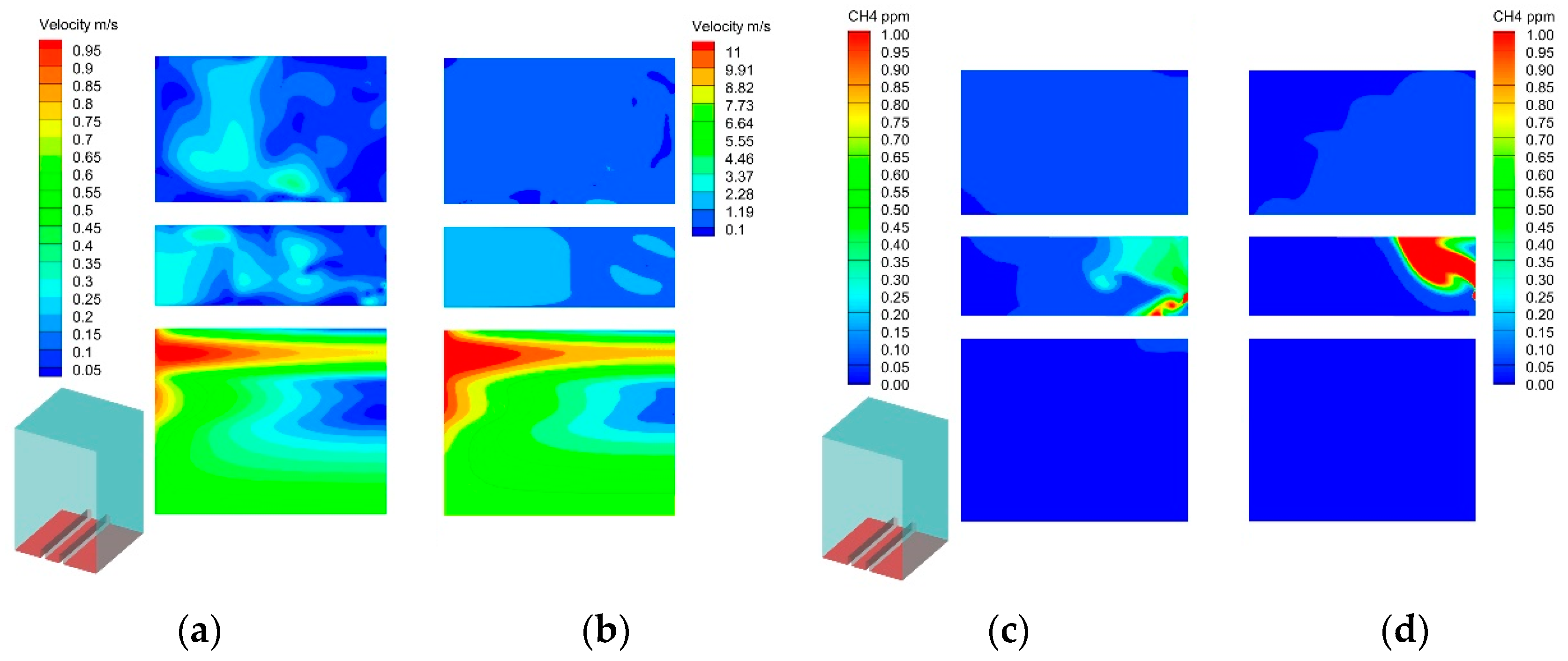
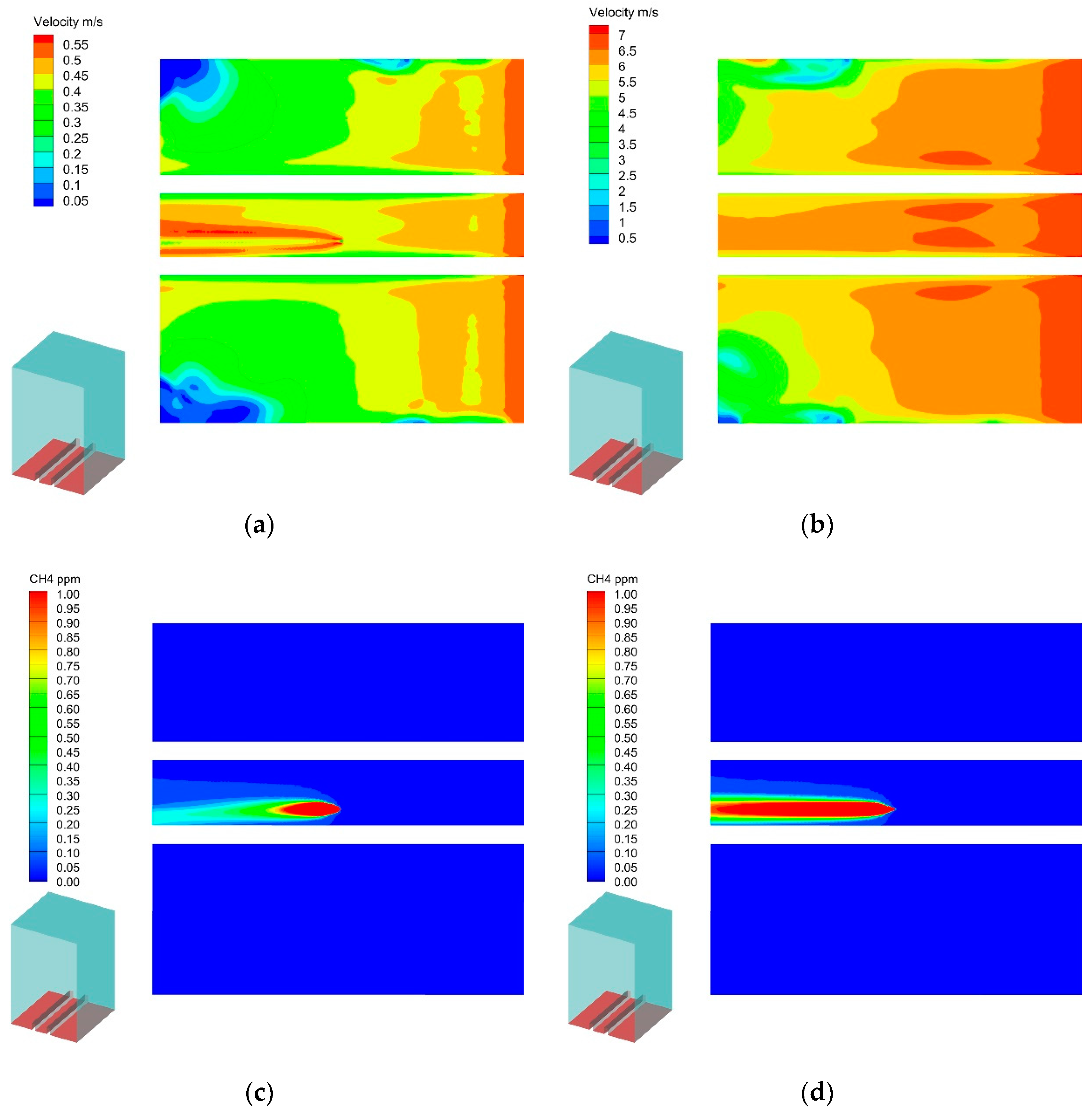
| Condition | Building Structure | Wind Directions | Beaufort Scale Levels |
|---|---|---|---|
| 1 | No building | South wind | 1, 2, and 6 |
| East wind | 1, 2, and 6 | ||
| 2 | South building | South wind | 1, 2, and 6 |
| East wind | 1, 2, and 6 | ||
| 3 | North building | South wind | 1, 2, and 6 |
| East wind | 1, 2, and 6 | ||
| 4 | North and south buildings | South wind | 1, 2, and 6 |
| East wind | 1, 2, and 6 |
Disclaimer/Publisher’s Note: The statements, opinions and data contained in all publications are solely those of the individual author(s) and contributor(s) and not of MDPI and/or the editor(s). MDPI and/or the editor(s) disclaim responsibility for any injury to people or property resulting from any ideas, methods, instructions or products referred to in the content. |
© 2024 by the authors. Licensee MDPI, Basel, Switzerland. This article is an open access article distributed under the terms and conditions of the Creative Commons Attribution (CC BY) license (https://creativecommons.org/licenses/by/4.0/).
Share and Cite
Zhu, T.; Chen, X.; Wu, S.; Liu, J.; Liu, Q.; Rao, Z. Numerical Simulation of Urban Natural Gas Leakage Dispersion: Evaluating the Impact of Wind Conditions and Urban Configurations. Atmosphere 2024, 15, 472. https://doi.org/10.3390/atmos15040472
Zhu T, Chen X, Wu S, Liu J, Liu Q, Rao Z. Numerical Simulation of Urban Natural Gas Leakage Dispersion: Evaluating the Impact of Wind Conditions and Urban Configurations. Atmosphere. 2024; 15(4):472. https://doi.org/10.3390/atmos15040472
Chicago/Turabian StyleZhu, Tao, Xiao Chen, Shengping Wu, Jingjing Liu, Qi Liu, and Zhao Rao. 2024. "Numerical Simulation of Urban Natural Gas Leakage Dispersion: Evaluating the Impact of Wind Conditions and Urban Configurations" Atmosphere 15, no. 4: 472. https://doi.org/10.3390/atmos15040472
APA StyleZhu, T., Chen, X., Wu, S., Liu, J., Liu, Q., & Rao, Z. (2024). Numerical Simulation of Urban Natural Gas Leakage Dispersion: Evaluating the Impact of Wind Conditions and Urban Configurations. Atmosphere, 15(4), 472. https://doi.org/10.3390/atmos15040472







